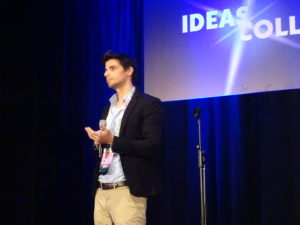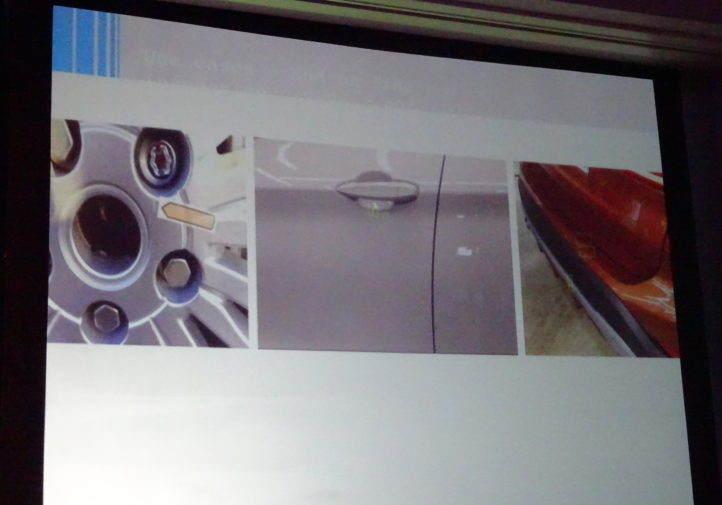
UVeye tech can eyeball vehicles in 3-D, detect auto body damage, hidden threats
By onAssociations | Business Practices | Insurance | Market Trends | Repair Operations | Technology
A technology company last month described how 3-D examination of vehicle exteriors and undercarriages could be combined with artificial intelligence to detect items ranging from wheel damage to terrorist bombs.
UVeye CEO Amir Hever said his company could even tease out mechanical issues using the sound of the vehicle.
His presentation to the inaugural Society of Collision Repair Specialists IDEAS Collide forum at SEMA provided a fascinating look at what the future of physical damage inspections by body shops and insurance companies could entail.
Hever recalled to the Nov. 2 audience two instances of getting his ride checked for threats in Israel. In the 15 years between them, the process still involved someone physically looking underneath the vehicle.
It took 2.5 years, but UVeye was able to build a system able to detect undercarriage anomalies visually.
“No one thought we could do it,” he said. “… We rented every possible car in Israel,” he said.”
In one instance, UVeye’s system also noticed an oil leak while scanning for threats. The company tweaked its artificial intelligence, and found it could also spot cracks, dents and rust on the chassis, he said.
By adding more views, the company could generate three-dimensional models and capture details about the vehicle in seconds.
“This year, UVeye introduced its latest line of products to the Automotive market with the 360° system, enabling automatic detection of a wide variety of mechanical issues, as well as damages to the outer frame of any vehicle,” UVeye’s website states. Another page describes capturing damage on panels and other parts relevant to collision repair.
The system has a way to inspect tires, looking for damage, measuring air pressure, and capturing tire specs and manufacturer off the writing on the wheel, according to Hever.
UVeye also has added microphone arrays to differentiate and isolate different sounds and was able to tease out “basically, every part” in the engine on its own, according to Hever.
The technology had potential on manufacturing lines, dealerships or a rental car company, according to Hever. He noted that he rented a car during his Las Vegas trip, and joked how he tried to mark the entire vehicle when asked to record any prior damage.
“You understand that something needs to be changed,” he said.
According to Hever, you could instead just drive the rental car through a UVeye station and have all of the damage automatically recorded.
Hever said that UVeye was currently focusing on manufacturers, logistics centers, dealerships and rental car companies and hadn’t started talking to insurers yet. However, he said an insurer had approached UVeye about potentially capturing the size and number of hail dents on a vehicle — a use case demonstrated by other companies already. He said UVeye would hopefully be ready for this by “mid-next year.”
UVeye’s business model removes a barrier to adoption and could potentially work out well for collision repairers on a budget.
“They don’t buy the hardware,” Hever said. Instead, UVeye installs it at a particular site and just charges the user per scan.
Later last month, UVeye announced it would work with Toyota Tsusho’s aftermarket department.
“The system will be deployed in auction sites and used on Toyota‘s used cars,” UVeye wrote Nov. 15. “It will reduce the cost of today’s vehicle inspection and will increase accuracy. Uveye will contribute to the evaluation of the life cycle of vehicles by detecting any anomaly such as an oil leak, rust, dents, etc.”
More information:
“UVeye and Toyota Tsusho Corporation to deepen the cooperation”
UVeye, Nov. 15, 2018
Images:
UVeye CEO Amir Hever’s Nov. 2, 2018, presentation to the inaugural Society of Collision Repair Specialists IDEAS Collide forum at SEMA provided a fascinating look at what the future of physical damage inspections by body shops and insurance companies could entail.
UVeye CEO Amir Hever on Nov. 2, 2018, described how 3-D scans of vehicle exteriors and undercarriages could be combined with artificial intelligence to detect items ranging from wheel damage to terrorist bombs. (Slide by UVeye; photo by John Huetter/Repairer Driven News)




